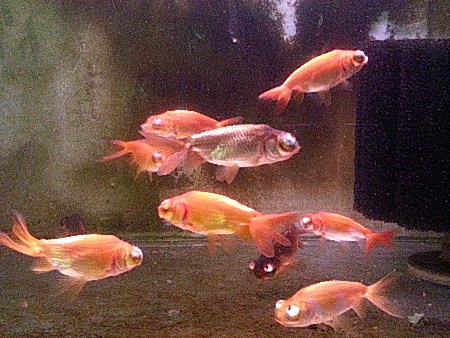| Back to Back Issues Page |
 |
|
The Goldfish Gazette, Issue #094 Juvenile Feeding for Growth October 30, 2021 |
Goldfish Care TipsA Free Monthly Resource For Goldfish Enthusiasts In This Issue Feeding Juvenile fish for maximum growth isn’t just about forcing as much food into the fish as possible. It is a combination of proper feeding, water temperature and water changes. Juvenile Feeding For Growth
I thought this might be an ideal time to set up an experiment to see how fast I could get these fish to grow and, more importantly, calculate how much food was being converted into growth (the food conversion ratio (FCR)). The Experiment12 Celestial juveniles 9 months old.Size – average body length 40mm. Aquarium size – 120 liters, water changed weekly. Water temperature – heated to 23oC. Food – Repashy Super Gold gel fed 3 times daily at 10% of their body weight (12 fish x 5g=60g total, so 6g of food daily). (I had used inaccurate scales which overstated the weight of the fish. The fish would have weighed closer to 3g, so for the first few weeks I was feeding at 17% of their body weight.) The aim is to grow 6 fish to between 75-100mm body length over spring/summer/autumn or approximately 7 months, and calculate how much food it takes. I know if I put these fish into a large pond full of all the natural food they could eat, I would achieve my target easily, probably within 3 months, but most aquarists don’t have large ponds at their disposal. I wanted an experiment that would provide information about food conversion rates, and anecdotally how often water changes are required to keep growth suppressing hormones low, as I have no way of measuring hormone levels in the water. Results So FarI have run the experiment for 8 weeks, taking measurements every four.The average fish size is now 55mm, a 37.50% increase, and weighs 7.35g. I have fed 340g of Repashy over the 8 week period, or 28g for every fish. The 28g has increased growth by 1mm for every 1.9 grams fed, and increased weight by 4.3g. This gives us a food conversion ratio (FCR) of 6.5 grams of food per gram of weight gained, not particularly flash considering other similar experiments using goldfish give figures of 2.75 to 4. This could in part be because I am using a highly developed Goldfish variety whereas most experiments use either Common or Comet Goldfish. I have increased the water changes to twice weekly as lack of water changes may have contributed to the high FCR. This is the only change I have made to the experiment. Will the Growth Rate Continue?I wasn’t expecting such fast growth from fish that had not been in ideal conditions for some months, were coming out of winter temperatures, and are not being kept in very high water temperatures.If this growth rate continues, the average size will be 75mm in another 8 weeks, 3 months ahead of schedule. To maintain this growth rate, I will need to increase food as the fish grow, (I am now feeding 8g a day), and start reducing numbers in the aquarium. I will maintain the water temperature at 23oC. The Bristol Aquarists Society October Newsletter had a timely article in it regarding Goldfish growth and reproduction. The article stated that there are 4 uses food is put to, metabolism, food storage (fat), reproduction and growth, with growth only taking place after the first three priorities have been satisfied. I have found that once juveniles become adults after 12 months, their growth rate slows markedly. I am keeping these fish in low daylight hour conditions, and so far, none of the fish are showing adult characteristics such as breeding stars. I will update the results next month. If the current growth rate has been maintained, the average size should be around 65mm.
Comments? Ideas? Feedback? I'd love to hear from you. Just reply to this e-zine and tell me what you think, or what topics you want covered. Next Month's Topic Color Changeswww.facebook.com/aboutgoldfish |
| Back to Back Issues Page |
